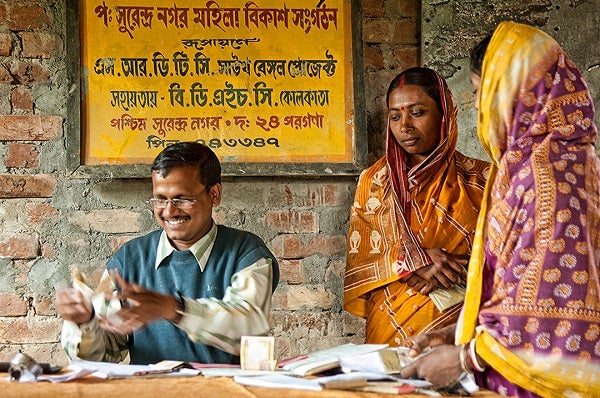Five Bright Ideas for Responsible Digital Finance
Delivery of financial services via mobiles, cards and other digital means is growing at a blistering pace in some markets. In Bangladesh, for example, annual growth in the number of mobile money users, agents and transaction volumes is averaging over 500 percent. This trend is hugely promising for helping previously unbanked people have more and better financial options. Many of us are asking how digital financial inclusion can be accelerated in more places and for more underserved consumers.
There is another important question we should be asking as we work to promote digital finance innovation and scaling: “What are reasonable steps that providers and other players should be taking to ensure that these services are being delivered fairly, transparently and safely?”
 Loan Day
Loan Day
Photo Credit: Nayan Sthankiya
Many are now mobilizing around a new banner -- “responsible digital finance” -- to tackle this question and find viable solutions that retail providers, industry bodies, regulators, consumer advocates, development agencies, and base-of-the-pyramid consumers themselves can make happen. Forthcoming research from CGAP and InterMedia’s Financial Inclusion Insights suggests that unless this standard can be achieved, the value of digital finance for low-income consumers will fall short of its potential, and the providers that have invested many millions of dollars in deployments around the world will not see the gains in uptake and usage of financial products beyond payment services that they need to meet their business goals.
As we work on forthcoming consumer research, the team at CGAP has five ideas that address the biggest risks and problems that low-income users (and prospective users) worry about the most:
1. Track fraud better and explore cooperative approaches to tackle it. The fraud topic is usually front and center in any responsible digital finance discussion, which is not surprising for innovative business models that are growing fast and relying so heavily on dispersed networks of lightly-trained and –supervised agents. Customers responding to user surveys in East Africa have reported fraud incidence as high as 11 percent. Providers admit that while their operational management systems focus on forms of fraud that affect them (such as loss of revenue from dishonest agents or external fraudsters), they may not have a complete enough picture of how fraud affects customers and agents (such as phony telco personnel who steal funds by tricking them to hand over their credentials). Operators are also beginning to see the benefits from better cooperation to share intelligence and be more proactive to nip fast-moving schemes in the bud.
2. Develop better models of agent management. Digital finance customers often rely on agents to transact on their behalf. While there are some pluses to this phenomenon, such as a less stressful experience for the customers, who are often unsure how to operate the services themselves, reliance on agents can open people up to risks like fraud and loss of privacy – and in the long run, consumers’ lack of confidence and trust to transact on their own behalf could limit the potential of digital finance. Mobile money operators, banks and non-banks are beginning to rethink their agent network management models, so as to create stronger incentives for service quality by agents, manage operational risks by “running a tighter ship,” and better empower consumers over time to choose and use services beyond payments.
3. Set and enforce service standards for digital finance network and system reliability. One surprising finding emerging from CGAP’s forthcoming research in Colombia, Bangladesh, the Philippines and Uganda is that while consumers worry about fraud and agent (mis)conduct, they worry more about network down time and interrupted mobile money transactions. This is a key driver of agent-assisted transactions. In particular, we are learning that consumers consistently worry about several things:
- Timed-out transactions (how many of us could navigate 5-6 screens, with strict time limits on each screen, on a cheap and small handset?).
- System down time and not knowing if their transaction has gone through.
- Being able to access funds that are in their wallet when they need them.
Frequent network and system down time is more than just an inconvenience to consumers – it equates to denial of service and contributes to risky consumer behavior, such as handing over their handset and PIN or leaving money with the agent to transact for them later (that day or even that month). Real-time transactions with receipts provide a critical first line of defense against the most common risks that mobile money users face.
4. Develop more user-friendly front-end interfaces. In many countries, digital financial services users report significant problems operating mobile money menus. The menu is often in the formal version of a language, while consumers often understand only the colloquial language. In addition, conducting transactions often requires many steps, which consumers say are very confusing. The forthcoming study in Colombia found complicated DFS menus were a top concern among users.
Complex interfaces lead to over-the-counter (OTC) and other assisted use, which opens digital financial services users to agent fraud and other risks. In Bangladesh, where OTC transactions dominate the market, difficulty conducting a transaction is a key driver for OTC use over registered, independent use. In addition, difficult menus lead to customer mistakes, which are hard to resolve because of poor recourse.
5. Make complaints handling faster, more timely, and free. In practically every market that has been studied, consumers express great concerns about whether there is any way to resolve problems such as sending money to the wrong number or tracking down transactions that have not gone through. CGAP has research underway to identify emerging good practices in complaints handling and redress systems for mobile money. Having dedicated and appropriately-trained call center staff is a good start. Providing toll-free lines seems only fair for customers seeking to resolve a problem that is low-value for the provider but not for them. Clear signage on how to complain and which party is responsible for your claim is also essential.
Together, action in these five areas would go a long way towards addressing the main pain points that stand in the way of enhanced customer value, business model success and financial inclusion progress from digitization of financial services. We don’t want digital financial inclusion to be “stuck in low gear,” with the vast majority of users limiting themselves to money transfer, preferring over-the-counter (OTC) services to wallets with more services on offer, and relying on agents to transact.
Please tune in to future posts in this blog series that will delve deeper into the latest research and practice on protecting digital finance customers from new and emerging risks. And, in the meantime, we welcome you to share your own bright ideas on advancing responsible digital finance.




Comments
Great article. We are trying
Great article. We are trying to establish product and services in South Africa and find this information extremely helpful.
Add new comment